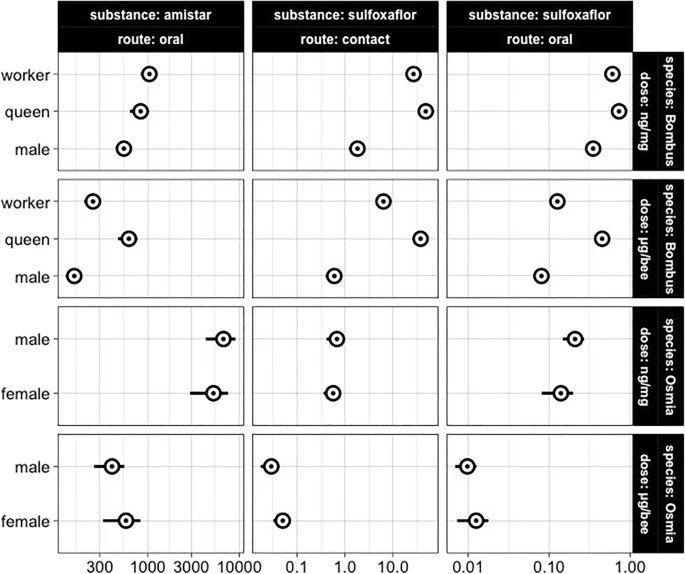pan-european assessment, monitoring, and mitigation of stressors on the health of bees
New PoshBee paper: Do all bees respond to pesticides the same way?
Different types of pesticides are used worldwide and, one way or another, bees get exposed to them. The evidence that such exposure is among the threats bees face is piling up and there are calls for their increased scrutiny in regulatory assessments. However, one significant concern is that existing frameworks could be biased towards assessing risks to the honey bee. In this context, PoshBee researchers considered it vital to test if all bees in fact respond to pesticides in the same manner, or if there are certain species dependencies.

The acute toxicity of Amistar (oral) and sulfoxaflor (oral and contact) across sexes and castes of B. terrestris and O. bicornis. Dots represent the median lethal doses, while horizontal error bars represent the 95% confidence intervals. The y-axis lists the bee castes and sexes, while the x-axis reports the doses (i.e., non-normalised = µg/bee or normalised = ng/mg body weight) on a logarithmic scale.
In their new paper, Intra‐specific variation in sensitivity of Bombus terrestris and Osmia bicornis to three pesticides, PoshBee researchers tested how bumblebees (Bombus terrestris) and solitary bees (Osmia bicornis) react to three different pesticides – a fungicide (Amistar), a herbicide (glyphosate) and an insecticide (sulfoxaflor). They also tested workers, males and queen bees. The researchers found that sensitivity to pesticides varied notably both within a species (males-worker-queen) and also across species (bumblebees-solitary bees). Bees’ weight proved to be a meaningful predictor of pesticide susceptibility, explaining part of the differences, but not all of them. This suggests that there are still unexplored mechanisms regulating pesticide sensitivity within a species.
The findings, described in this paper, point to very important – and yet overlooked – aspects of the risk assessment of pesticides in bees. Differences in vulnerability within and between species are essential in determining whether or not pesticides are safe and more research is needed on the other ~20,000 bee species to ensure their safety.
Read the full paper here.